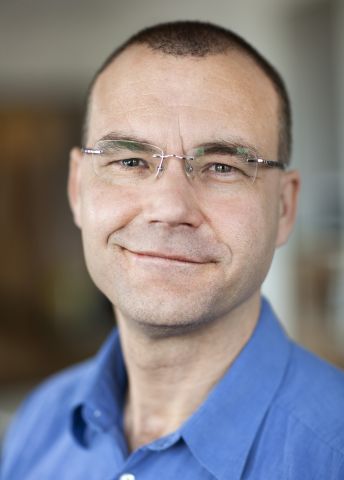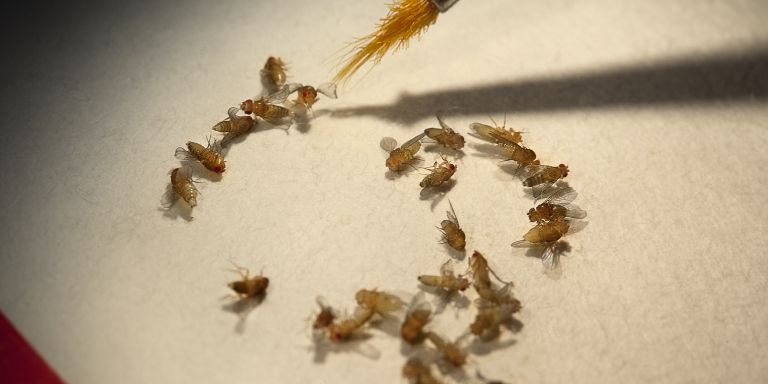
Stefan Thor
Professor of developmental biology
Wallenberg Scholar
Institution:
Linköping University
Research field:
The structure and degeneration of the central nervous system.


Professor of developmental biology
Wallenberg Scholar
Institution:
Linköping University
Research field:
The structure and degeneration of the central nervous system.
Stefan Thor is a professor of developmental biology at Linköping University. He is mainly pursuing two research thrusts in his lab: the structure of the central nervous system and its degeneration. To help him, he has, besides his research team, thousands of fruit flies.
About two thirds of a fruit fly’s genes are the same as human genes. By adding or removing normal or manipulated genes in the fly, it’s possible to study the functions of genes. These flies can also be readily, quickly, and inexpensively raised in the lab. Fruit flies are therefore a highly popular model system for researchers all over the world.
The central nervous system is made up of two kinds of cells, nerve cells and glia cells. They comprise a vast array of distinct cell types and hence different functions. The extreme diversity of cell types and their intricate connections is why several known neurological disorders that involve the death of nerve and glia cells, such as Parkinson’s and Alzheimer’s diseases, are difficult to cure.

In his lab, Stefan Thor therefore creates flies with Alzheimer’s-like conditions in order to try to understand the disease process, working in collaboration with Per Hammarström and other Linköping scientists.
“We can introduce and activate human Alzheimer’s genes in the flies. They find it harder to fly, eat, and mate. Their nervous systems degenerate, and they die prematurely,” he explains.
Their longevity is shortened dramatically, from 50 days to five days, when the flies have been given a gene with severe Alzheimer’s. It appears that primarily two proteins, A-beta protein and Tau, are involved.
“We know that they’re toxic, but not how they become so. They occur naturally in the body.”
In collaboration with AstraZeneca, Stefan has tested some 30 substances to determine whether they might slow down the development of the disease.
“We found a couple of substances that increase the longevity of the sick fly by 15 percent,” he says.
“The funding from the Wallenberg foundation is like manna from heaven. Now I can expand my research on the connection between the degeneration of the nervous system and the development of Alzheimer’s, even though my portfolio in that field is not all that strong as yet.”
In other words, experiments that were merely in their cradle were nevertheless promising, although the step from fly to humans is a big one. But the pharmaceutical industry is skeptical, having spent many millions looking for drugs for Alzheimer’s. And Stefan is not so sure whether his collaboration with AstraZeneca will continue.
“I’m convinced the research community will find a drug, but it will take time, maybe 15 years,” he says.
But he doesn’t believe it will be sufficient to find one substance. The solution will be a combination of several, just as with anti-HIV preparations.
There are currently at least seven main theories about what goes wrong when Alzheimer’s develops. Several of them are probably correct, which means this work must be pursued on a broad front.
The scientists also see a pattern that is emerging in degenerative disorders, in spite of the fact that neurological diseases affect different types of nerve cells.
“Even though different proteins are involved, the Tau protein turns up strikingly often, and also in Parkinson’s, for one. It seems as if there’s a common degenerative process, and this gives us hope that certain drugs might be effective for several different diseases.”

Stefan Thor’s primary research field is to understand how nerve cells, which start out as stem cells and are identical to each other, gradually develop into specialists in certain areas.
“Some nerve cells control muscles, while others might have a data-processing function in the brain. The question is how they know what identity they should assume, and what they are supposed to do. The nervous system is the body’s most complex system,” he says.
Stefan and his research team have contributed some insights into how nerve cells establish their identity.
“It’s a stepwise process, from stem cell to mature neuron or glia.”
Stem cells are formed in many places in the early embryo and are affected by various signals that tell them where they are in the embryo, such as the brain or further down, in the spine.
“When the cells have received this information about where they’re located, for example in the fore-brain, showers, cascades, of information start flowing that ultimately determine exactly which neurons and glia cells they are to produce. For instance, we could see that the so-called Hox genes are active in the process and that they work as a kind of GPS system for the body.”
But he emphasizes that it is still unclear how these processes work in detail.
“We don’t know how stem cells read the “GPS information” i.e., how they know that certain cells are to be placed in the brain and others in the spinal cord. It’s not clear how this information is conveyed.”
But how stem cells are trained to become specialists with thousands of different functions is not the only mystery. It’s also a puzzle how they know how many cells they are supposed to produce.
“It’s a process we know even less about. In the cerebrum there are billions of certain types of cells, while other cell types, such as those in the hypothalamus, amount to only about ten thousand. How do they know how many are needed for various functions? This is a key question to answer in order to understand cancer, and to design effective stem cell treatments in the future,” says Stefan Thor.
Text Carina Dahlberg
Translation Donald S. MacQueen
Photo Magnus Bergström